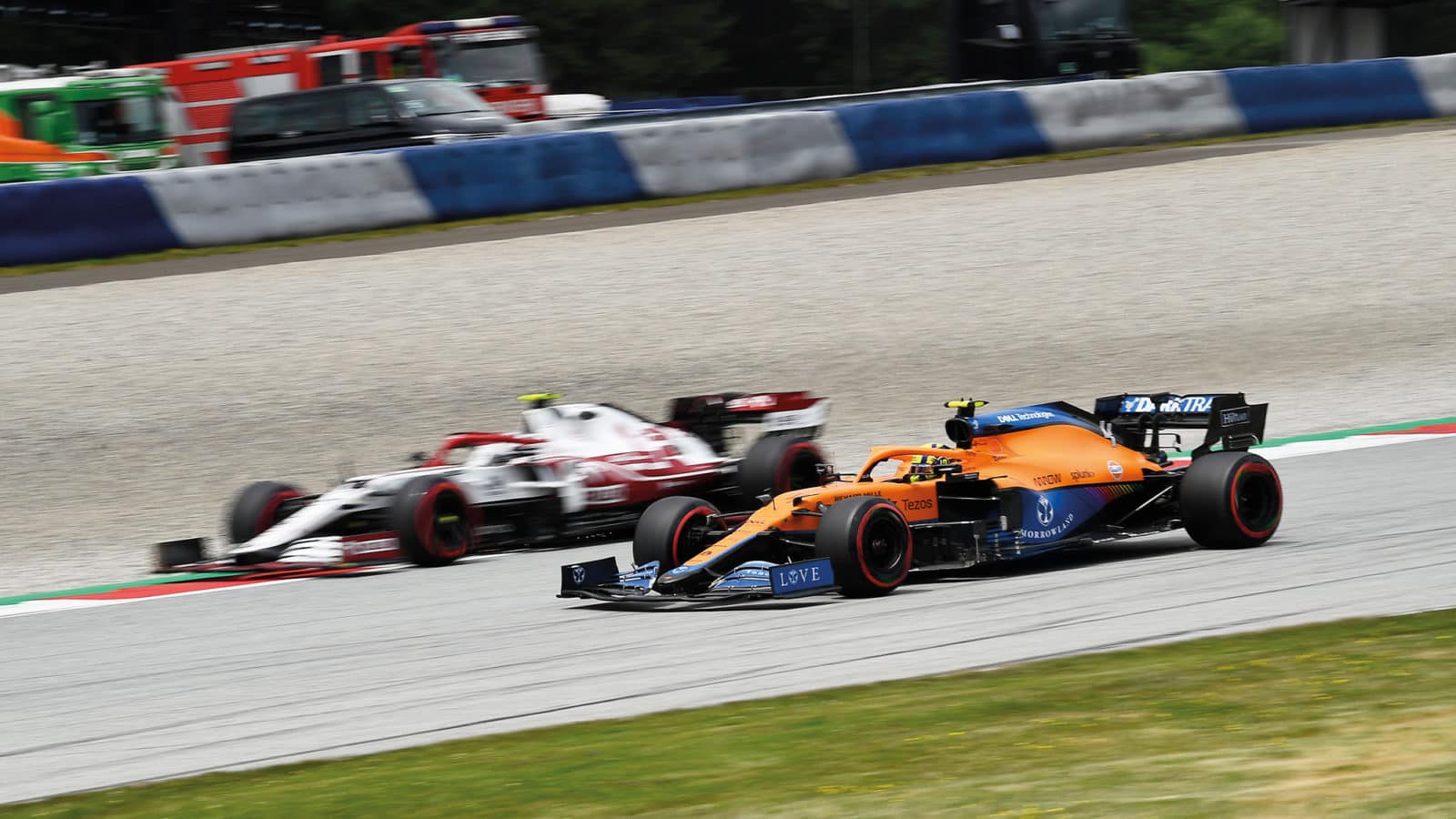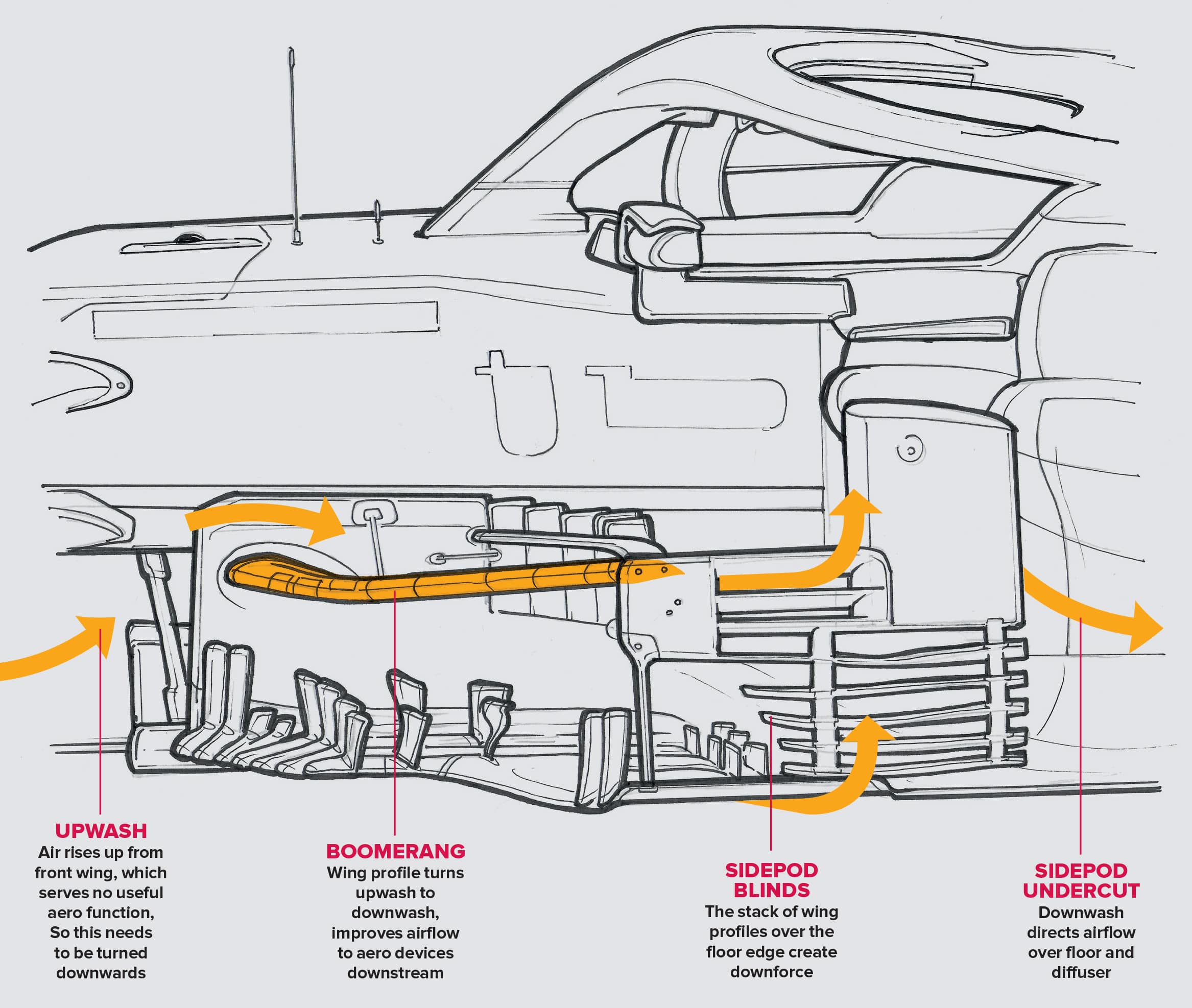McLaren’s boomerang
While other F1 teams have all but halted development work to focus on 2022, at Woking the tweaks continue

The MCL35M arrived at the Austrian GP with a softer ‘Z’ Z-floor. Here’s Lando Norris in practice at the Red Bull Ring
Illustration Craig Scarborough
McLaren is rivalling Red Bull in how many new parts are being produced as each team continues to heavily develop their cars despite the looming challenge of the all-new 2022 aero regulations. McLaren arrived in Hungary with a heavily revised barge board arrangement for its MCL35M. To understand the probable reasons for an apparently innocuous change requires some backstory.
This is a highly distinctive car within the constraints of the quite prescriptive technical regulations, with several unique solutions. The two hard points of distinction have been the diffuser and rear wing.
The McLaren’s wing has a small main plane and big flap compared to other cars (which will give it a powerful DRS effect but less than optimum performance in non-DRS running).
“In ground effect cars, the sealing job was fulfilled by skirts”
The McLaren diffuser’s central tunnel is uniquely defined by the full-length strakes which are permitted around the central 500mm of the car’s width. Other cars have wider central tunnels which in extending beyond the 500mm zone are obliged to have much shorter strakes finishing further above the ground. The length of the strakes outside the 500mm area was shortened by regulation into this season, as part of a downforce-reducing initiative. The implication is the McLaren’s diffuser performance will be more centralised – i.e. more of its total effect will be derived from that central tunnel.
Both these points of distinction seem to have driven a development direction unique to the McLaren, which has proved highly responsive to its programme. In France the car received a new rear wing endplate with lateral rather than upright slots at the bottom, the only car to feature such an arrangement. Generally, the lower endplate slots are there to optimise the aerodynamic relationship between the diffuser and rear wing as some of the airflow exiting the diffuser is directed to the underside of the rear wing above. Creating a bigger pressure difference between the top surface of the wing and its underside will make it work more powerfully. The endplate slots pull the diffuser’s flow further outwards, energising more of the wing underside’s width.
These will be particularly important on a McLaren with more of its diffuser performance derived from the central tunnel and with a relatively small rear wing main plane. Maximising the flow from the central part of the diffuser could lead to the outboard end of the rear wing underside being starved.
In opting to change the lower slats from upright to horizontal, it would appear McLaren is targeting the lowest regions of the area behind the diffuser. The aerodynamic effect of the slots will vary across the speed range and rake angle of the car and it could be that the lateral slots give a better overall performance, given the unique diffuser geometry and rear wing configuration. If the outer areas of the floor outside the central tunnel are less energised because of the unique diffuser geometry, it’s quite conceivable the airflow there will need more help in being redirected.
With a high-rake concept of car (which all but the Mercedes and Aston Martin are), teams will always be seeking ways of maximising the rake angle before the diffuser stalls. This will inevitably be at the lowest speeds, as the rear of the car rises as the downforce forcing it down on its suspension rapidly bleeds away as speed reduces. The lower the speed at which the diffuser works, the higher the rake angle which can be used, rake which multiplies the negative pressure beneath the floor through the venturi effect (the way that airflow increases in velocity as it’s forced through a constricted area – the leading edge of the floor, in this case – with a big expansion area behind it).
An essential part of maximising that effect is preventing the underfloor airflow from leaking out the sides. In the original ground effect cars of the late ’70s/early ’80s this sealing job was fulfilled by skirts, but they were longago banned. Now, the seals are made by vortices of spinning air along the outer edges of the underfloor. This was made more difficult to do by the 2021 banning of slots in floor edges. Given that the area of the floor was also reduced this year by a regulation cutting away a triangular section of it, clawing back the lost downforce represented quite a challenge.
The ‘Z-floor’ has been the widespread solution, one which McLaren adopted from the Spanish GP. This Z-shaped cut-out in the floor’s edge, in tripping the air around it, induces the desired vortices on the underside edge. Which is good. But in making that cut, you lose some permitted floor area. Which is bad.
In July’s Austrian GP McLaren revised its Z-floor, with a softer Z that took away less of the permitted floor area. It features a myriad of tiny vanes around it to accelerate the air into it in compensation for the less extreme Z. The McLaren’s diffuser geometry, in prioritising the central tunnel, may well have made the outer areas of floor contribute relatively less and hence this sustained effort in switching it on.
The combination of the lateral rear wing endplate slats and the revised Z-floor should have allowed the car to be run with a higher rake angle by better energising that area behind the diffuser. Running the car with more rake changes the way all the aerodynamic surfaces work. So as each new development part is fitted so the aerodynamicists then re-optimise the car around the new airflow. In this case, it has led to the new barge board on which the standard ‘boomerang’ piece sitting above the guide vanes now slants upwards towards the rear. This suggests an airflow more in line with a higher rake angle than before.

